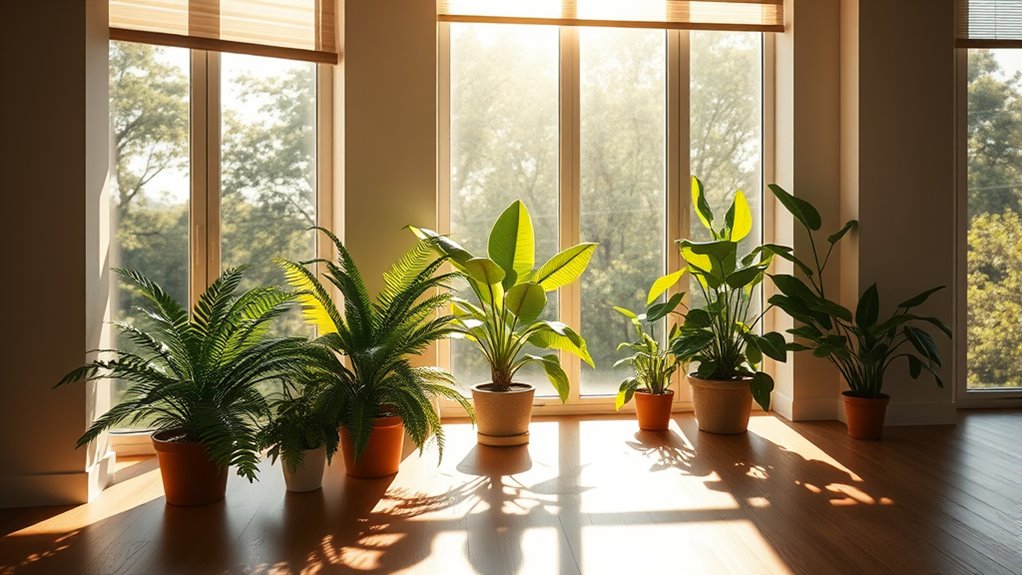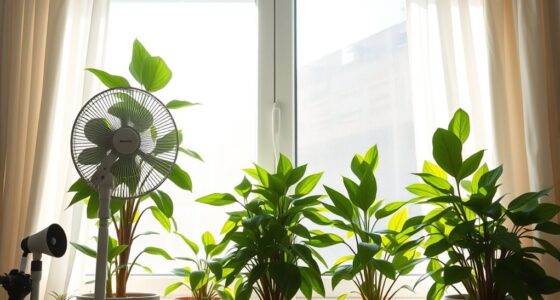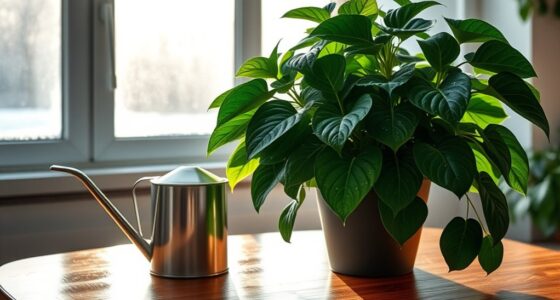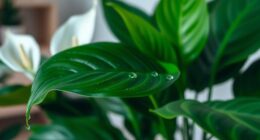To optimize your indoor plant placement during intense summer sunlight, position sun-loving plants near south-facing windows while shielding more delicate ones with sheer curtains or blinds. Adjust placement based on season to prevent scorching, and increase watering and drainage to keep roots healthy. Guarantee good airflow and humidity levels tailored to each plant’s needs. By making these adjustments, you’ll help your plants thrive even during the most intense summer days—stay tuned to learn more insights.
Key Takeaways
- Place sun-loving plants near south-facing windows for maximum light exposure, and move shade-sensitive plants away from direct sun.
- Use sheer curtains or blinds to diffuse intense summer sunlight and prevent leaf scorch.
- Adjust plant placement during peak summer hours to avoid direct, harsh rays and dehydration.
- Ensure proper soil drainage and watering frequency to combat increased evaporation and prevent root rot.
- Improve airflow around plants with open spacing or fans to reduce humidity buildup and promote healthy growth.
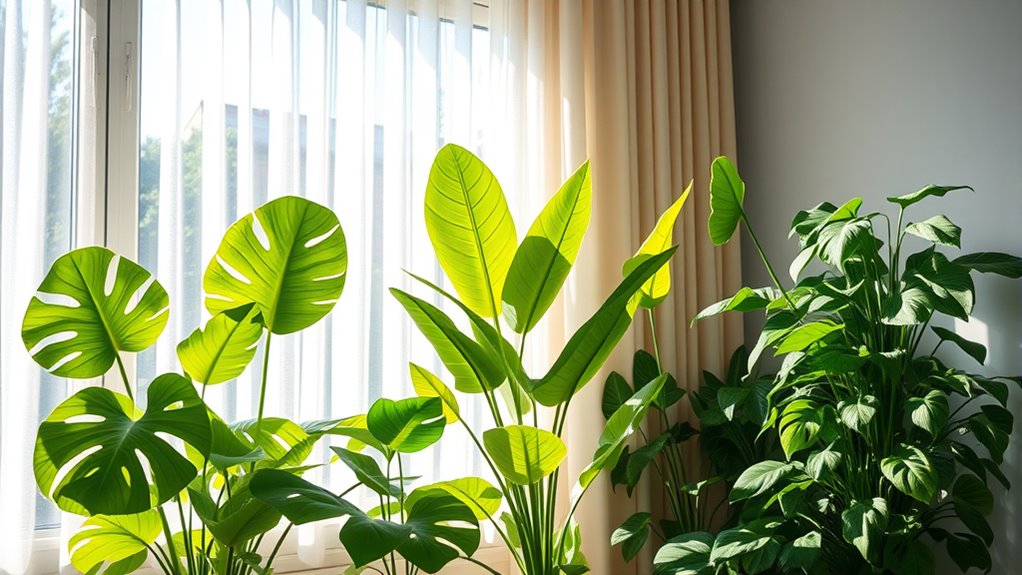
Have you ever wondered where the best spots are for placing indoor plants to thrive? During intense summer sunlight, choosing the right location is essential to keep your plants healthy and vibrant. Sunlight can be a double-edged sword—while many plants love bright light, too much direct sun can scorch their leaves or cause dehydration. To optimize placement, consider where your windows are and how sunlight filters into your home. South-facing windows generally provide the most intense sunlight, so if you place plants there, ensure they’re suited for high light conditions or provide some shade during peak hours. East- and west-facing windows offer more moderate light, which may be gentler on sensitive plants. North-facing windows typically bring in less direct sunlight, making them ideal for shade-loving species.
Once you’ve identified the best spots, focus on your watering schedule and soil drainage, which are crucial for thriving indoor plants in summer. During intense sunlight, plants tend to dry out faster, so you’ll need to adjust your watering routine accordingly. Check the top inch of soil regularly—if it feels dry, it’s time to water. Avoid overwatering, which can lead to root rot, especially if the soil doesn’t drain well. Proper soil drainage is vital; use pots with drainage holes and well-aerated soil mixes to prevent water from sitting at the bottom. This helps roots breathe and reduces the risk of disease. Additionally, understanding vetted product formulations and choosing the right soil and fertilization methods can support your plants’ health during the summer months.
Positioning your plants correctly also means considering airflow and humidity levels. Good air circulation prevents mold and pests and helps evaporate excess moisture from the soil. If your home tends to be humid, selecting pots with good drainage and avoiding overly dense soil mixes can help prevent waterlogging. Conversely, in dry environments, misting or using humidifiers can keep plants healthy without risking overwatering.
Frequently Asked Questions
How Often Should I Rotate My Indoor Plants for Even Sunlight Exposure?
You should rotate your indoor plants regularly to guarantee even sunlight exposure. A good plant rotation schedule involves turning them about once a week, depending on their sunlight exposure frequency. This helps prevent uneven growth and sunburn. Keep an eye on how the sun hits your plants and adjust the rotation as needed. Consistent rotation improves overall health and keeps your plants thriving during intense summer sunlight.
What Are the Signs of Sunburn on Indoor Plants?
Did you know that overexposure to sunlight can cause indoor plants to develop sunburn symptoms? You’ll notice leaf discoloration, often turning yellow or brown, and sometimes crispy edges. These signs indicate your plant is getting too much direct sun. Keep an eye on your plants and adjust their placement if you see leaf discoloration or scorched patches. Protect your plants by providing partial shade during peak sunlight hours to prevent sunburn symptoms.
Can Artificial Grow Lights Replace Natural Sunlight During Summer?
You might wonder if artificial lighting can replace natural sunlight during summer. While artificial lighting, especially sunlight simulation grow lights, can supplement or replace natural light, they often don’t fully match the spectrum and intensity of real sunlight. For best results, use high-quality grow lights that mimic natural sunlight closely, ensuring your indoor plants get enough light, even on cloudy days or when natural sunlight is limited during the summer.
Which Indoor Plants Tolerate Direct Intense Sunlight Best?
You’re wondering which indoor plants handle direct intense sunlight best. Succulent varieties excel here due to their high sunlight tolerance. Plants like Aloe Vera, Jade Plant, and Agave thrive in bright, direct light without burning. Keep in mind, these plants need plenty of sunlight daily to stay healthy. Position them near south-facing windows or in sunny spots, ensuring they get the full sun they crave for ideal growth.
How Does Humidity Affect Plants in Sunny Indoor Locations?
Humidity effects play a significant role in indoor plant care, especially in sunny locations. When humidity is high, your plants absorb more moisture, helping them stay healthy and vibrant. In low humidity, they may struggle with dehydration, leading to browning leaves and stress. To guarantee ideal growth, monitor humidity levels and adjust accordingly, using humidifiers or misting, so your sunny indoor plants thrive and stay lush year-round.
Conclusion
Remember, proper placement can make all the difference for your indoor plants during intense summer sunlight. If you’re worried about scorching or wilting, start with gradual exposure or use sheer curtains to filter the light. Don’t let fear hold you back—adjusting your plant’s position is simple and rewarding. With a little care, you’ll enjoy healthy, thriving greenery even in the hottest months. So, give it a try and watch your plants flourish indoors!

